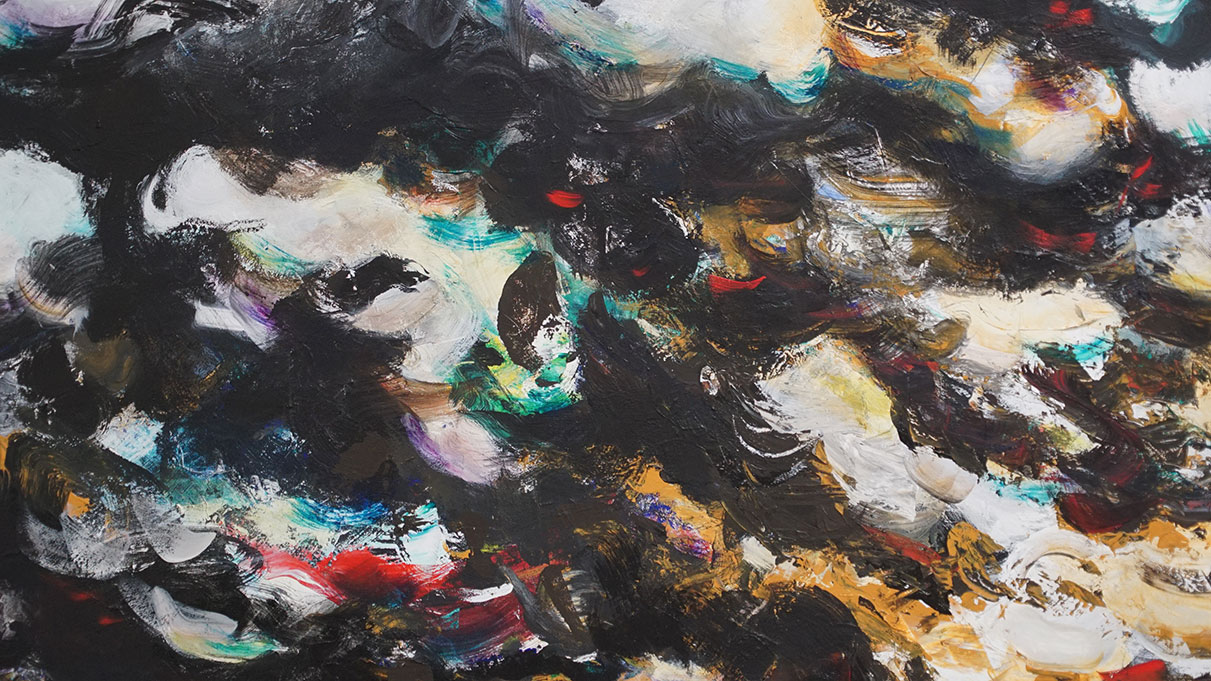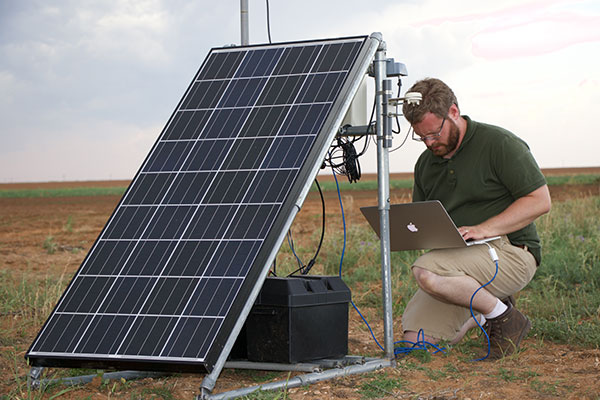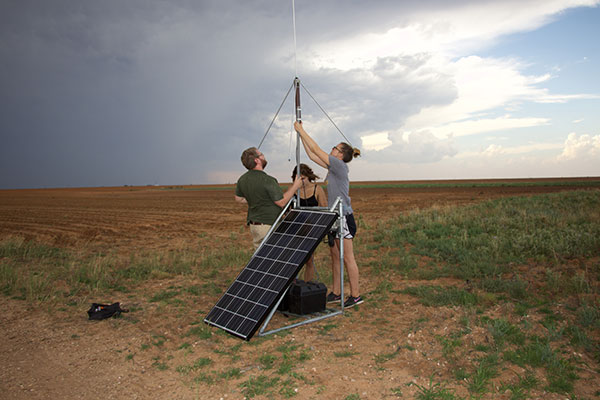Abstract Art Meets Atmospheric Science
By: Sally Logue Post
Professors of art and atmospheric science collaborate on a new project that illustrates the science of lightning

Lightning is beautiful, deadly and not well understood. Lightning is part of every thunderstorm, but meteorologists don't know where it forms in a cloud or how it acts once it has formed. Eric Bruning, Texas Tech associate professor of atmospheric science, has been chasing storms and answers to those questions for several years.
Bruning joined Texas Tech's Atmospheric Science Group in the Department of Geosciences in 2010. He believes that understanding how lightning works could help scientists predict where and when a massive thunderstorm could turn dangerous – a prediction that could save lives on the ground.
In 2014 he received a prestigious CAREER Award from the National Science Foundation (NSF). But his grant application wasn't all science, he turned to an artist to help him make his work more interesting and understandable to the lay person. The end result of the collaboration will be an exhibition at the Museum of Texas Tech University.
"An important part of the grant, from NSF's point of view, is how you will do active outreach and education, and I was interested in doing something a little bit outside the box," he said. "I've always enjoyed data visualization and looking at our data in graphical form. So I figured it would be interesting to work with someone who has a lot of experience working visually."
That desire to look at his science through a different lens led him to Tina Fuentes, professor of art at Texas Tech and nationally known artist.
Fuentes was director of the School of Art when Bruning first contacted her about finding an artist interested in working with him. When her first message to her colleagues went unanswered, she invited the scientist to her office to see if she could determine how best to help him.
"When Eric came into my office he started talking about lightning and he used words like color, line and texture," Fuentes said. "I thought to myself 'wait, you are describing art, you're using my vocabulary.'"
His use of vocabulary wasn't a coincidence. He suspected that Fuentes would respond to the word texture, a word used by artists more than scientists, and he was right.
"I think my charts and graphs and videos are pretty interesting, at least to me and other scientists," Bruning said. "But Tina's art demonstrates what lightning looks like when it fills a cloud in a very different way than my charts. She has stripped away the normal scientific trappings and captured the essence of the storm, and I think that's a very effective way to convey to the public what I as a scientist might not be able to get across in my ordinary scientific communication style."
The Art
With Fuentes on board, Bruning submitted his grant application, and within a few months was awarded funding for a five year project. With that notification it was time for the artist to enter the world of science.
"I looked at Eric's work, and I went to scientific meetings – I was the one who looked different," Fuentes said laughing. "The first time I went to a meeting I thought 'oh my goodness,' but it was fascinating, though some people would look at me while I was at the back of the room taking notes."
Fuentes also sat in on Brunings' students' presentation and went storm chasing with them.
"I have looked at the heavens more than I ever have before," she said. "I bet I've taken more than 1,000 photos of cloud formations."
While her two-dimensional art is stunning, Fuentes wasn't quite satisfied.

"I was thinking: how can I best recreate the combustion I saw in the clouds? How can I make that visual? I really wanted people to see the stroke, not me making the stroke."
Inspiration hit one day when Fuentes was watching the weather on TV. She realized the green-wall technology used to project the image behind the meteorologist could work for her.
"I made a makeshift green wall in my studio and I wore a green suit," she said. "We were able to pull me out of the video and all you see are my paint strokes. Now that I had this idea, I didn't want to project the video on a flat wall. I had a small bundle of cotton in my office and one day I thought, that's it, I can use the cotton as a background for my video."
She visited Texas Tech's Fiber and Biopolymer Research Institute of the Department of Plant and Soil Science and asked them if they could give her some bags of cotton to build eight 5-by-4 foot panels.
"The cotton panels look gorgeous," Fuentes said. "The color of the cotton was a bit different from bag to bag."

The Science
Bruning is one of the few meteorologists who are studying lightning. Most scientists in that field are from a physics or electrical engineering background. Bruning is trying to describe how lightning fills a cloud.
"Everyone has seen lightning coming from the bottom of the cloud, but there is probably 10 times more lightning inside the cloud that you don't see," he said. "I'm looking at how the turbulence in the cloud ends up making very small flashes when it's really turbulent and very large flashes when it's smoother inside the cloud."
Turbulence is one of the most challenging scientific questions that remain unsolved, he said. Using lightning measures, which as of late have become much easier to obtain, Bruning believes that if he can relate how lightning behaves in a cloud to the turbulence in the storm, there is a possibility of addressing some of those long-standing questions.
"The more turbulent the storm, the smaller the lightning flashes because they are being stirred around more, like in a cup of coffee when you add creamer," he said. "You can see a texture to that, and the lighting channels follow that structure."
The result of Bruning's work could combine with the radar images scientists use now to predict severe storms and improve public safety warnings.
The National Oceanic and Atmospheric Administration (NOAA) has recently launched a new weather satellite that for the first time has a lightning mapping instrument. Before coming to Texas Tech, Bruning worked with NOAA's satellite program.
"The new satellite allows meteorologists to see lightning flashes day or night," he said. "If there are a numerous thunderstorms in an area, the question becomes how to tell which one is the most dangerous. If we can better understand how the turbulence of the storm is affecting lightning, then maybe we can use that to determine which storm is the one that could become most dangerous by looking at what is happening with the lightning."

A Bright Future
After a couple of years working together, the scientist is convinced that the artist is capturing what he is seeing in the clouds.
"There is a degree of realism in the texture Tina's capturing and how her brush strokes fill the space," he said. "Science is always trying to distill complicated things down to their essence and I think that Tina's doing that as well. She's distilling the clouds and the lightning into these sort of abstract forms that end up being very powerful because you have to focus on the essence of what's happening instead of focusing on the realistic look of it."
The art may not directly help Bruning answer scientific questions, but he hopes it will help lay people better understand the research.
"Tina has stripped away the normal scientific trappings and captured the essence," he said.
In addition to an exhibition at the Museum of Texas Tech University later this year that will combine his science with Fuentes' art, the two are setting up presentations to high schools in the South Plains area that will involve Bruning's graduate students.
Fuentes says she hopes the exhibit and the presentations will reach students in a new way and inspire some to look more seriously at the research within the arts. For Bruning, the collaboration has proven to be a new recruiting tool for graduate students.
"I think young scholars respond to the idea of interdisciplinary work, and it gives them one more reason to look at Texas Tech for graduate school," he said.
Both the artist and the scientist hope their collaboration spawns new partnerships.
"NSF loved the idea," Bruning said. "I think the program managers were excited, but also maybe a little bit nervous because this was a bit outside what they typically fund. Lightning is pretty and that's what's great about working with an artist, she can convey the beauty and help me communicate the science at the same time."
Discoveries
-
Address
Texas Tech University, 2500 Broadway, Box 41075 Lubbock, TX 79409 -
Phone
806.742.3905 -
Email
vpr.communications@ttu.edu
